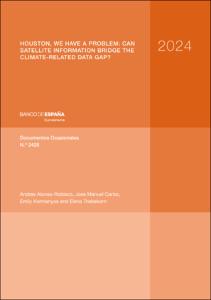Houston, we have a problem: can satellite information bridge the climate-related data gap?
Authors
Issue Date
2-Sep-2024
Physical description
36 p.
Abstract
Los bancos centrales y los supervisores internacionales han identificado la dificultad de obtener información climática como uno de los obstáculos clave que impiden el desarrollo de productos y mercados financieros verdes. Para cerrar esta brecha de datos, puede ser necesaria la utilización de información satelital procedente de los sistemas de observación de la Tierra (EO, por sus siglas en inglés). Para comprender mejor este proceso, analizamos el potencial de la aplicación de datos satelitales a las finanzas verdes. En primer lugar, resumimos el debate político desde la perspectiva de la banca central. A continuación describimos brevemente los principales desafíos que para los economistas supone abordar el formato de datos satelitales y las metodologías cuantitativas para medir su materialidad económica. Finalmente, utilizando el modelado de temas propio del procesamiento del lenguaje natural, realizamos una revisión sistemática de los estudios académicos recientes para descubrir en qué áreas de investigación se utilizan actualmente este tipo de datos en relación con las finanzas verdes. Encontramos los siguientes temas: materialización del riesgo físico (incluido el riesgo agudo y crónico), deforestación, energía y emisiones, riesgo agrícola y uso y cobertura del suelo. Concluimos con un análisis integral sobre la materialidad financiera de esta fuente alternativa de datos —mapeando estos dominios de aplicación con nuevos instrumentos y mercados financieros verdes en desarrollo, como es el caso de los bonos temáticos o los créditos de carbono—, así como con algunas consideraciones clave para el debate económico.
Central banks and international supervisors have identified the difficulty of obtaining climate information as one of the key obstacles to the development of green financial products and markets. To bridge this data gap, the use of satellite information from Earth Observation (EO) systems may be necessary. To better understand this process, we analyse the potential of applying satellite data to green finance. First, we summarise the policy debate from a central banking perspective. We then briefly describe the main challenges for economists in dealing with the EO data format and quantitative methodologies for measuring its economic materiality. Finally, using topic modelling, we perform a systematic literature review of recent academic studies to identify the research areas in which satellite data are currently being used in green finance. We find the following topics: physical risk materialisation (including both acute and chronic risk), deforestation, energy and emissions, agricultural risk and land use and land cover. We conclude with a comprehensive analysis on the financial materiality of this alternative data source, a mapping of these application domains to new green financial instruments and markets under development, such as thematic bonds or carbon credits, and some key considerations for policy discussion.
Central banks and international supervisors have identified the difficulty of obtaining climate information as one of the key obstacles to the development of green financial products and markets. To bridge this data gap, the use of satellite information from Earth Observation (EO) systems may be necessary. To better understand this process, we analyse the potential of applying satellite data to green finance. First, we summarise the policy debate from a central banking perspective. We then briefly describe the main challenges for economists in dealing with the EO data format and quantitative methodologies for measuring its economic materiality. Finally, using topic modelling, we perform a systematic literature review of recent academic studies to identify the research areas in which satellite data are currently being used in green finance. We find the following topics: physical risk materialisation (including both acute and chronic risk), deforestation, energy and emissions, agricultural risk and land use and land cover. We conclude with a comprehensive analysis on the financial materiality of this alternative data source, a mapping of these application domains to new green financial instruments and markets under development, such as thematic bonds or carbon credits, and some key considerations for policy discussion.
Publish on
Documentos Ocasionales / Banco de España, 2428
Subjects
Datos satelitales; Sensores; Finanzas verdes; Bancos centrales; Satellite data; Sensors; Green finance; Central banking; Recogida de datos; Finanzas sostenibles; Recursos naturales y medio ambiente
Appears in Collections:












